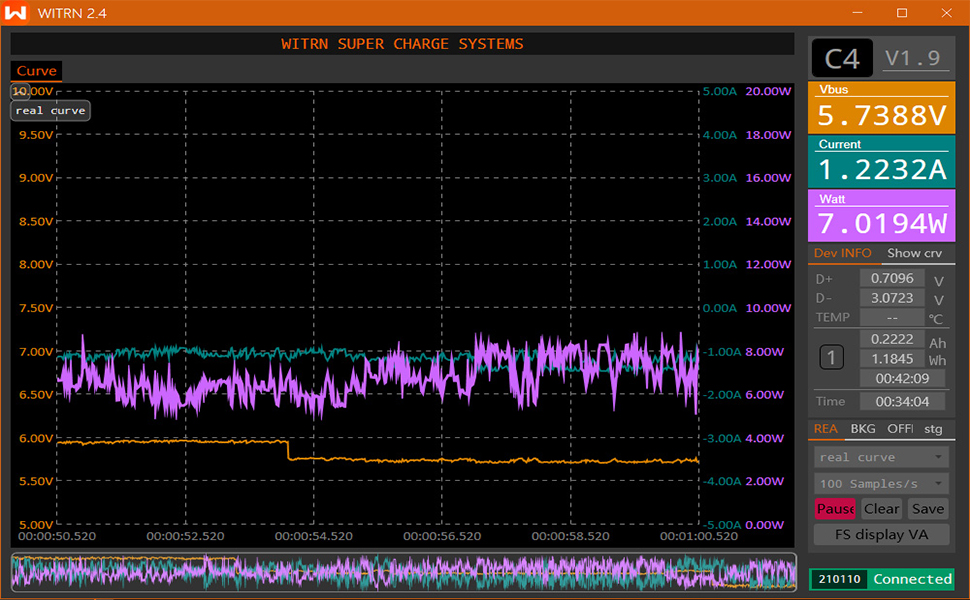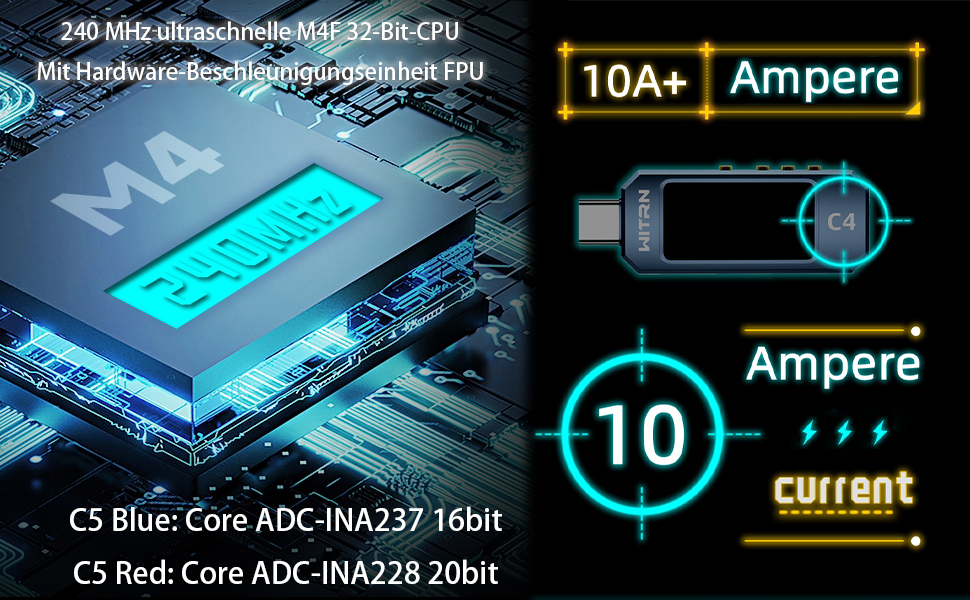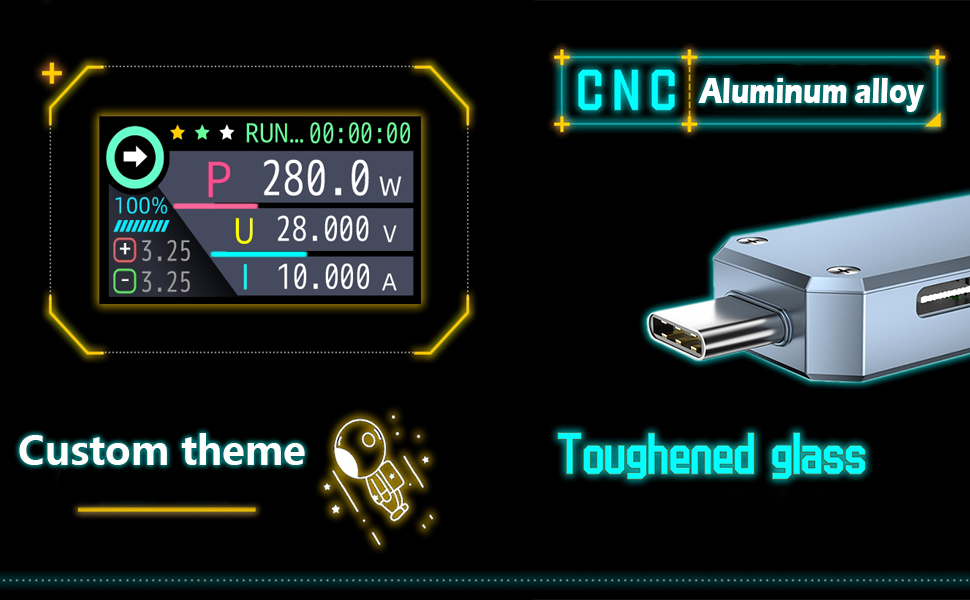Customer Services
Copyright © 2025 Desertcart Holdings Limited
Desert Online General Trading LLC
Dubai, United Arab Emirates






⚡ Master your USB power game with pro-grade precision!
The UM25C USB Meter is a high-speed, professional-grade USB multimeter and load tester featuring PD3.1 support up to 48V, 11A current capacity, and advanced spectrum analysis. It boasts a vibrant 1.47-inch IPS display, durable FRAM memory, and PC connectivity for data logging and customization, making it an essential tool for precise USB charging and power bank capacity testing.




C**F
Great multimeter
This is so useful for Arduino programming. It passes through the USB data pins so I can program the Arduino with this plugged in. It allows me to see power consumption in real time without the hassle of unplugging my Arduino over and over. This is especially great because it can measure down to the .0001A current (100 micro amps) my previous USB multimeter could only measure accurately down to .01A (10 milliamperes). This allows me to more accurately see my current draw while putting an Arduino into a sleep mode to make sure it is actually consuming very low energy for my portable battery powered arduino projects. I’ve been able to measure an Arduino pro mini consuming about .0400A while in an active idle state all the way down to .0017A in sleep mode. This device allows me to confirm my code is working the way I intended it to since you couldn’t otherwise tell if it is in sleep mode or not. If I did it the old fashioned way I’d have to use a regular multimeter with the big heavy cables and rig it up in series with the power supply to measure the current. That was such a pain to do since you had to reconnect it every time to did a programming change. In fact most of the time when I used the regular multimeter the heavy cables would pull my light Arduino projects off my desk and smash it into the floor causing me to curl up into a ball on the floor and cry since my breadboard of dozens of parts got disconnected or broken.For everything else this device works awesome as well. Great for testing phone charging rates, USB power banks actual capacity, actual discharge current of a USB port, etc. worth every penny.P.S. the included 1A/2A discharge board is super sketchy. It gets up to 245°F if you leave it plugged into a 2A USB port. Hopefully you don’t forget about it. I ended up giving it to my worst enemy after I 3D printed a housing to make it look like a USB flash drive. I then bought Drok’s $13ish USB discharge board with a built in fan/heatsink as well as a display and pot to adjust and see current draw up to 5A. That one still gets hot, but is very much less likely to cause a fire if you forget about it. The more you know.
B**L
Designed for Geeks - but seems to work fine
This little meter/analyzer has a lot of functions that are helpful in evaluating the performance of:1) USB power sources2) USB cables3) USB devices to be chargedA successful, full-speed charging of a modern USB device requires compatibility between all of the above components and folks often blame the wrong component. If you are technically inclined, you can study the USB charging protocols and use this device for verification/debug. You can also use it to determine the total energy transferred. But even a novice user can inspect the default screen to see the results of voltage and current negotiations and determine if their attached device is not charging (0A), slow charging (0.5A or less) or fast charging (1-2+A). The screen is colorful and easy to read (can be difficult to see in bright sunlight, but that is not a typical usage scenario for this device). The user interface takes quite a bit of study to understand and is complicated by the following: First, the buttons that control the device have multiple functions (long press is different function than short press). Secondly, the button functions are softkeys and their function is labeled on the screen itself. That is OK, but one of the functions allows rotation of the screen in 90 degree increments, and while the rotation itself is useful, it re-labels the physical buttons. The control buttons protrude slightly beyond the edges of the meter - that make them easy to press, but can result in unintended button presses when the device side is pressed against a flat surface. Have not had this long enough to evaluate long-term reliability, but assuming it lasts at least a couple of years, a great tool tool for the price!
A**R
well worth the price.
I work as a computer and IT tech and this really helps in the day to day troubleshooting
S**N
Great tool!
It's amazing how much different chargers and cables vary. Some 1 Amp chargers won't deliver 5 V at 1 Amp. Others may do it for a few minutes but charge rate falls off before the device even begins to charge. Not all cables are created equal. Sort out your cables that work and the ones that should just be recycled.
K**E
Accurate - Bright Screen - Bluetooth - Lots of Options
A USB Tester is a should-have tool even if you own just the basic electronics such as a phone or a tablet. (I have discovered numerous USB cables and chargers that had super low outputs or just didn't work at all.)It's a must have tool if you are into electronics and like to tinker. I fall into the tinkerer group and I have several USB testers, but this one so far is has the most functionality.While the simplest testers will show voltage and amps, this one will do a whole lot more and has the ability to work with Micro and USB-C cables, has Bluetooth, and has an app as well as software for the computer. It also comes with a load source that allows you to check cables.The 1.44" color screen on this tester besides being pretty is much easier to read and low-light conditions.I have to admit I'm a little overwhelmed with all the options, but I'm starting to get the hang of this USB tester. So far I have not used the app or computer software but will hopefully find time in the near future to tinker with one or both.So far I am happy with the functionality and accuracy of this USB tester as well as the included load source. The storage tin that it comes in is also kind of nice. Once I have played with this tester some more I will update this review.
S**F
計測
電圧電流、消費電力、充電時間も計測でき表示も綺麗です。ブルーツルースもすぐつながりアプリも使いやすいです。エクセルに記録を残せるのですが、1秒単位で記録されるので時間が長いとファイルが膨大になります。記録時間の設定が10分とか15分に1回の記録に変更できればよかったですね。負荷抵抗は1Aと2Aの切り替えができます。しかし1Aでもすぐに抵抗が触れないほどに熱くなります。なので2Aは怖くて使用できません。もう少し余裕のある抵抗を使用してほしかったです。でもこの金額ではしょうがないんでしょうね。
S**N
特に問題なし、動作良好です。
問題なく、使えています。連携できるソフトもダウンロードして使用できました。簡易的な日本語マニュアルもついています。あえて、あげるとしたら日本語マニュアルが簡易的なので詳細をもう少し記載していたほうが初めて使う人には親切かもという程度です。使い慣れている人には、まったく問題ありません。
E**G
Not working with PD (power delivery)
Just bought it for testing, the display is nice, easy to use, but I have some problems:1. PD (Power Delivery) is not working, I have a few PD chargers (single port, multi port) and it doesn't turn on (Using USB-A to C is OK, so the USB-C IN seems working), forum says we need to connect a PD load, but still not working (I used 3 different phones, and Macbook as well, no display, no charging)2. When I use USB-A IN (or micro USB IN), USB-C out connecting Samsung Galaxy S10, Pixel 4XL, or other phone, the phone will say "not supported USB device". Pixel 4 cannot charge, Samsung is charging at 5V 0.5A (what?? without PD it should still at least 5V 2A?!)I am not sure if I get a bad one, or something wrong with this device?
N**F
これでわかった機器の特性
USB充電機器を手に入れると必ず使って測定しています。我が家には1,2.1,2.4Aの3つの充電ポートを持つスタンドがあり、各機器を各々に挿したときのアンペアを確認してます。この測定器を使って初めて知ったのですが、機器により充電状況がいろいろで、測らないとわからないというのが実感です。・どこに挿しても1A(スマホ)・どこに挿しても2A(急速充電対応モバイルバッテリー)・挿したポートに従ったアンペア(2017年以後のIphone、Ipad)特に、モバイルバッテリーが1Aに挿しても2Aで充電されているところにびっくりしました。なるべく電池を痛めないように、時間に余裕がある時は低いアンペアで充電しておりますが、この測定器を使って機器の特性を調べ、ポートに従ったアンペアで充電される機器を優先的に割り当て、どこに挿しても同じアンペアの機器を空いたところで充電するようにしています。
A**ー
Nice product
Really cool device
Trustpilot
1 week ago
2 months ago